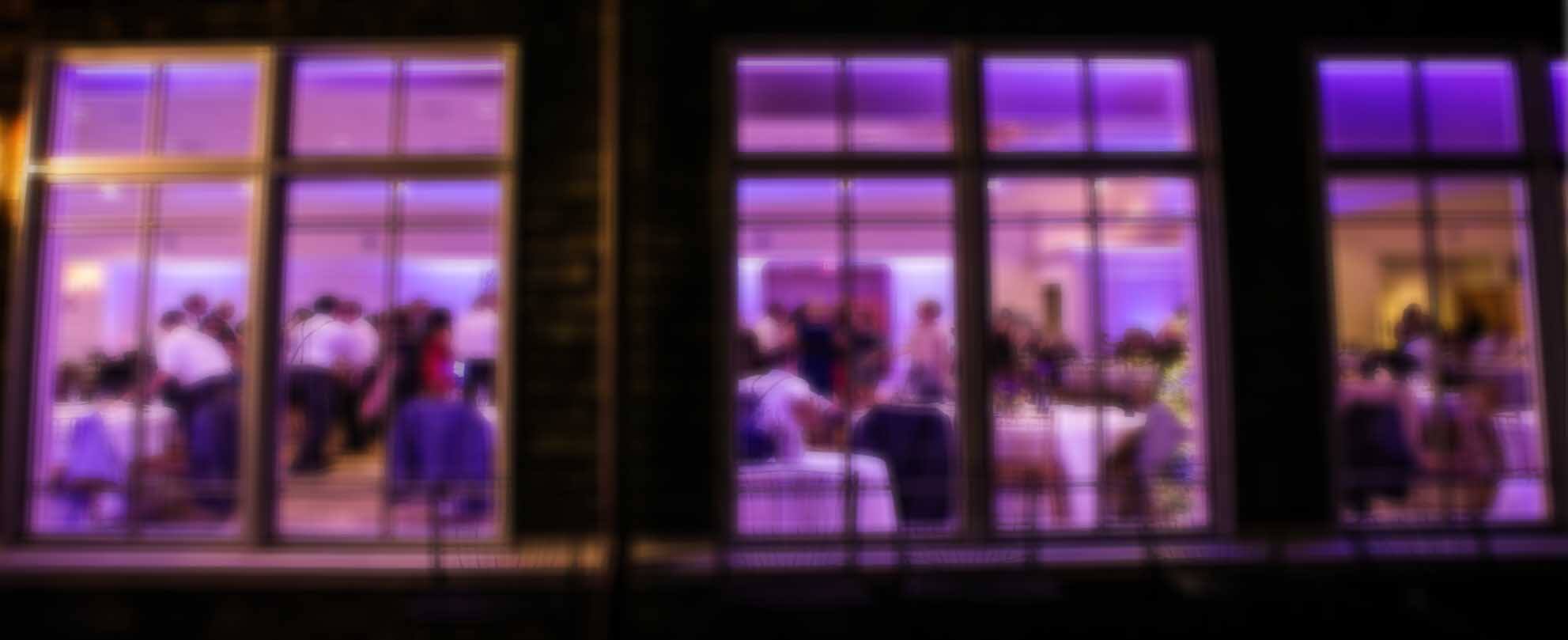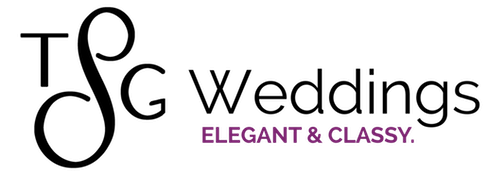An Education On
Up Lighting
Up Lighting 101
Everything You Need To Know
The wedding entertainment industry is highly competitive, with couples searching for the best value and vendors offering crossover services to stay ahead. Up-lighting, though relatively new to weddings, has grown in popularity since the early 2000s. With the mainstream introduction of affordable LED technology in the early 2010s, the market quickly became saturated with options for couples looking to enhance their wedding ambiance. So, what sets one provider apart from another? That’s a complex question, but we’ll break it down into a few key categories to make it as straightforward as possible.
Wired Vs. Wireless
At TSG Weddings, all of our lighting is 100% wireless, powered by built-in lithium-ion batteries. This means no messy cords or tape on floors or carpets—just clean, unobtrusive setups. The wireless design gives us the flexibility to place lights anywhere, whether it’s under a table, inside an unused fireplace, on a mantel, or even on a windowsill.
Many high-end venue managers actually require vendors to use wireless lighting to maintain the aesthetic and eliminate safety hazards. Like most couples, they prefer a polished, wire-free look that enhances the space without distractions. With TSG Weddings, you get beautiful, safe, and seamlessly integrated lighting for your big day!
Incandescent VS. LED
If you’re considering uplighting for your event, here’s an important distinction to know. Traditional uplighting, often referred to as Par-Cans, used wired incandescent fixtures with white bulbs. To create colors, these lights were covered with translucent, colored cellophane sheets (gels). Once the light was on, the color couldn’t be changed. These older lights consumed a lot of electricity, generated excessive heat, and posed safety concerns, which is why they’ve fallen out of favor.
LED (Light Emitting Diode) technology has revolutionized uplighting. LEDs are energy-efficient, produce vibrant colors without the need for gels, and remain cool to the touch. They also last for thousands of hours, making them a reliable and modern solution for events. LED uplighting isn’t just the future—it’s already here, and it’s transforming event spaces everywhere.
The ABC’s Of RGBAWUV
Let’s break it down simply. RGB stands for “Red, Green, Blue,” while A stands for “Amber,” W for “White,” and UV for “Ultra Violet.” An RGBAWUV LED light includes all six of these LED colors. However, this doesn’t mean it can only produce those six shades. Modern LED lights are incredibly advanced and can mix colors directly inside the fixture. For example, combining a little red with a little blue creates purple! This internal color mixing allows these lights to produce a vast range of colors from just the six base tones.
What sets our LED lights apart is how they mix colors inside the lens. This ensures that the colors projected onto your venue are vibrant, accurate, and true. Unlike some fixtures that mix colors externally—resulting in “rainbows” or strange color tints on walls—our lights provide a smooth, flawless wash of color for a polished, professional look.
RGBA, RGBW, RGBAW, RGBAWUV
More letters, yup. It’s not confusing though, we promise. You already know RGB! “A” stands for “amber” and “W” stands for “white”. These are the latest and the greatest! Most companies, including TSG Weddings transitioned into LED lighting and bought RGB fixtures. Amber and white LED’s were expensive, and uncommon at the time. We could make MOST colors that my brides asked for with an RGB fixture, but it was definitely lacking something. The addition of white, amber, and UV LED’s into an RGB fixture changed the game. With just an RGB LED, there’s really no good way to make a brilliant white, or a deep rich amber color. Having those LED’s built into the fixture not only allows us to create those two colors properly, but the range of other colors we can create now by having 6 base colors instead of 3, is almost limitless.
DMX (Not The Rapper)
Last acronym, we swear! DMX stands for Digital Multiplex. We bet if you asked around, almost no one would know that! It’s an industry standard protocol for controlling lighting and effects. Lights get “DMX Addresses”, so the lighting controller (a piece of hardware or software) can talk to them and tell them what to do. You might be thinking: “Why are we telling you this, I don’t care.” Here’s why it matters: When a DJ or lighting company runs uplighting, each fixture gets a DMX Address. From the lighting controller, the operator tells the lights what to do. Now, if every light has the same DMX address, they’re all going to do the same thing at the same time. However, if each light has its own unique DMX address, each can be controlled individually, yet simultaneously. This gives the operator the freedom and control to create an infinite amount of possibilities with how the lights can be used. In over 10 years, we have never once come across another DJ company besides TSG Weddings, to individually DMX address their uplighting fixtures.
Keeping Control
Sometimes, we work alongside other vendors who provide lighting for events, and we’re perfectly fine with that. We believe in the power of free enterprise. However, if your venue offers complimentary uplighting but refuses to let you hire your own, it’s worth questioning why. In most cases, having multiple vendors isn’t a problem—it can actually help you achieve a more personalized wedding vision.
What we don’t like is when we work with another vendor who simply sets up their lights and leaves. What happens if something goes wrong or a light stops working? These are risks we’re not willing to take. That’s why, whenever we book uplighting, we include a dedicated lighting technician. Our technician will set up the lights and stay on-site throughout your event. Not only will they ensure everything runs smoothly, but we’ll also happily adjust the lighting as needed throughout the evening—at no extra charge. You may be surprised how changing the lighting after dinner can reinvigorate your guests and create an energized dance floor!
Size Matters When It Comes To Output
One thing most companies are likely not to tell you is the size, and/or power output of their fixtures. You might hear terms like watts, lumens, or beam angles when they talk about output. You might also hear things like “pucks”, “cans”, or “light-drops” when they talk about the style of fixture. You might even hear terms like “par” versus “bar”, when talking about the shape of the fixture. In our experience, what you really need to know is 10 watts of light output, is good for about 10 feet of height. 20 for 20, and so on. There is a direct relationship between the output of the fixture being used, and the height of the walls/ceilings that you’re trying to light. Nothing looks more silly than a beam of light shining half way up the wall. Don’t misunderstand, we’re not saying small lights are bad. Small lights actually serve a great purpose on mantels, underneath tables, on ledges, window sills, and all sorts of unique places bigger lights won’t fit. Know what to ask, and what to expect!
Show Me The Money
Uplighting is an investment in your wedding. Is it going to make/break your wedding? No, of course not. Is it going to have a drastic and dramatic impact on your entire event? Absolutely. Uplighting can create WOW from the moment guests arrive, and enhance a dance floor later in the evening. Over the past couple of years, we’ve seen several function halls including up-lighting in their packages as an incentive to book. We’ve also seen photographers offering uplighting too. Uplighting makes the venue look better. It makes photos look better. Be cautious when these opportunities present themselves. Discounted, or “included free” uplighting is cheaper for a reason. TSG Weddings aims to competitively price our uplighting packages. We’re constantly upgrading our services, and adjusting our prices accordingly. We truly believe that our product, and level of service, is second to none.

Are Our DJs Available
On Your Date?
Choose your event date to get an instant reply
with more information about our services.
- January
- February
- March
- April
- May
- June
- July
- August
- September
- October
- November
- December
- 1
- 2
- 3
- 4
- 5
- 6
- 7
- 8
- 9
- 10
- 11
- 12
- 13
- 14
- 15
- 16
- 17
- 18
- 19
- 20
- 21
- 22
- 23
- 24
- 25
- 26
- 27
- 28
- 29
- 30
- 31
- 2026
- 2027
- 2028
- 2029
- 2030
- 2031
- 2032
- 2033
- 2034
- 2035
- 2036
- 2037
- 2038
- 2039
- 2040
- 2041
- 2042
- 2043
- 2044
- 2045
